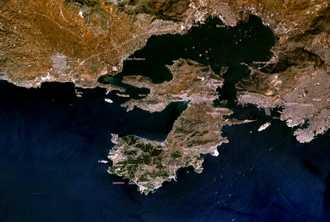Battle of Salamis
The Battle of Salamis was a naval battle between an Alliance of Greek city-states and the Achaemenid Empire, Persia. It happened in September 480 BC in the straits between the mainland and Salamis Island. It was part of the Greco-Persian Wars.[2]
| Battle of Salamis | |||||||||
|---|---|---|---|---|---|---|---|---|---|
| Part of the Greco-Persian Wars | |||||||||
 Satellite image of Salamis, with the straits to the mid-right | |||||||||
| |||||||||
| Belligerents | |||||||||
| Greek city-states | Achaemenid Empire | ||||||||
| Commanders and leaders | |||||||||
|
Eurybiades, Themistocles |
Xerxes I of Persia, Artemisia I of Caria, Ariabignes † | ||||||||
| Strength | |||||||||
| 366–378 ships a |
~1,200 shipsb 600-800 ships c | ||||||||
| Casualties and losses | |||||||||
| 40 ships | 200 ships | ||||||||
|
a Herodotus gives 378 ships of the alliance, but his numbers add up to 366.[1] b As suggested by several ancient sources; c Modern estimates | |||||||||
Although heavily outnumbered, the Greek Allies were persuaded by the Athenian general Themistocles to bring the Persian fleet to battle again. The Persian king Xerxes was also anxious for a decisive battle.
The Persian navy sailed into the Straits of Salamis and tried to block both entrances. In the cramped conditions of the Straits the great Persian numbers were an active hindrance, as ships struggled to maneuver and became disorganised. Seizing the opportunity, the Greek fleet formed in line and scored a decisive victory, sinking or capturing at least 200 Persian ships.
As a result, Xerxes retreated to Asia with much of his army, leaving Mardonius to complete the conquest of Greece. However, the following year, the rest of the Persian army was decisively beaten at the Battle of Plataea and the Persian navy at the Battle of Mycale. Afterwards the Persians made no more attempts to conquer the Greek mainland. These battles of Salamis and Plataea mark a turning point in the Greco-Persian wars; from then on, the Greek cities would take the offensive.
Battle Of Salamis Media
Ionian soldier (Old Persian cuneiform 𐎹𐎢𐎴, Yaunā) of the Achaemenid army, c. 480 BC. Xerxes I tomb relief. Depiction of a Greek trireme: this graphic was first published in May, Elmer; Stadler, Gerald; Votaw, John; Griess, Thomas (series ed) (1984) Ancient and Medieval Warfare: The History of the Strategies, Tactics, and Leadership of Classical Warfare, New Jersey, United States: Avery Publishing Group ISBN:
Fleet of triremes based on the full-sized replica Olympias
The Ionian fleet, here seen joining with Persian forces at the Bosphorus in preparation of the European Scythian campaign of Darius I in 513 BC, was part of the Achaemenid fleet at Salamis. 19th century illustration.
Greek triremes at Salamis.
References
- ↑ Herodotus, The Histories Perseus online version
- ↑ Strauss, Barry S. (2004). The Battle of Salamis: The Naval Encounter that Saved Greece--and Western Civilization. Simon and Schuster. ISBN 978-0-7432-4450-3.
Other websites
| Wikimedia Commons has media related to Lua error in Module:Commons_link at line 62: attempt to index field 'wikibase' (a nil value).. |
- Battle of Salamis Archived 2013-09-23 at the Wayback Machine









